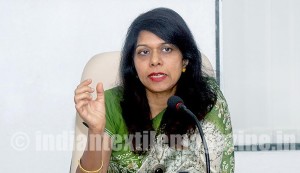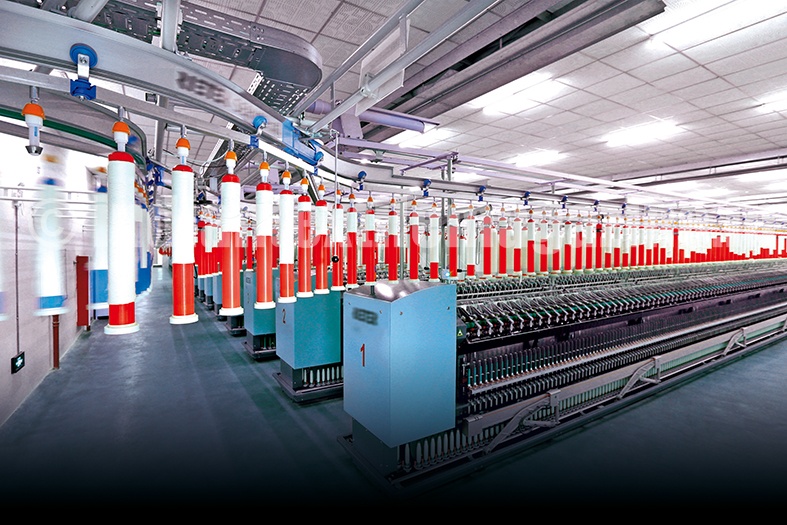Full Govt. backing assured with all infrastructural facilities
Can we change the world order? This was the crucial question at the conference at India ITME 2016 in Mumbai. Sharing their views, the leaders of the textile industry were unanimous in their view that the industry is witnessing a paradigm shift worldwide and India can seize the opportunity to be a dominant player.

In her inaugural address, The Textile Commissioner, Dr. Kavita Gupta, assured a more conducive business environment by the Government through policies and other infrastructural support. She said: “R&D is a key to this growth. The Government has added R&D investments in textile machinery manufacturing to be getting all benefits as any other sector. There is no reason why India cannot overtake China in the near future. We are already more competitive than China in labour, power and manufacturing costs in the textile industry.”
Mr. R.D. Udeshi, President, Polyester Value Chain, Reliance, later shared the possible roadmap towards India achieving a target of achieving $300 billion in textile exports. The textile sector is one of the largest contributions to India’s exports with approximately 11 per cent of total exports. India’s overall textile exports during FY 2015-2016 stood at $40 billion.
Faster technology upgradation, marketing innovation, better policy framework, focus on quality and enhancing production capacities were identified as some of the growth drivers for textile and apparel business towards achieving the mission. The ‘Make in India’ initiative by the Government needs to be leveraged to achieve scalability and be globally competitive.
Industry stalwarts such as RK Vij of Indo Rama, Subash Bhargava, MD, Colorant Ltd., RK Rewari, CMD, Morarjee Mills, BB Sharma, CEO, Sintex Spinning, JV Rao, CEO, National Skill Development Council, Caroline Averbeck, International Trade Centre, etc., expressed their expert views.
Dr. B.K. Behra, HOD, Textiles, IIT, shared the latest advancements in various processes in textiles. He stated that more efficient machines that are smaller and consume less water and energy need to be adopted. Sustainability would play a critical role in tomorrow’s technologies. “To save the impact on the environment, the industry needs to replace urea urgently,” said Bulent Eksoy and Sandeep Arora of Polyspin, India.
Linen and lincel are gaining faster acceptance as they are more sustainable in nature as a raw material, claimed Mr. Manish Mehta, MD, Sundrem TexVentures.
Going by the interest shown by world technology leaders at India ITME 2016, the textiles landscape in India is about to change and the industry’s mood can be assailed easily. Participation from 38 countries, a huge presence of foreign visitors and an overwhelming participation by Indian textile machinery manufacturers are a testimony of the intent to grab the opportunity by the Indian domestic textile industry.
Textile consumption within India is growing rapidly. Also, with China’s share in world textiles trade about seven times of that of India, the Indian manufacturers are sensing better exports in future. The six-day exhibition witnessed dozens of product launches and is proving to be an effective platform for joint ventures and collaborations between the stakeholders of textile industry in India and overseas.
There were 25 new launches of global importance, reflecting the latest innovations and technology in the sector. Foreign and domestic business leaders, academicians, research scholars, government officials from countries such as Philippines, Myanmar, Bangladesh, Sri Lanka, Iran, Turkey, Brazil, Indonesia, Poland, Malaysia, Kenya, Ethiopia, Egypt, etc., visited the Mumbai show, confirming that India is not only a strong market but also is explored as a hub for training and skill development by many countries for textiles and textile engineering.
The India ITME Society is four-decade old non-profit organization with a vision to support the industry through exhibitions facilitating investments and joint ventures and technology transfer. Gujarat and Karnataka participated in this event as State partners. This event was also supported by the Department of Heavy Industry, Textile Ministry, the Government of India and the Government of Maharashtra, making it the most important platform for Governments and industry members to interact and work together.
The idea of “Make in India” in textile engineering was promoted among the foreign business visitors, while propagate Government schemes and incentives for the textile industry in India.
